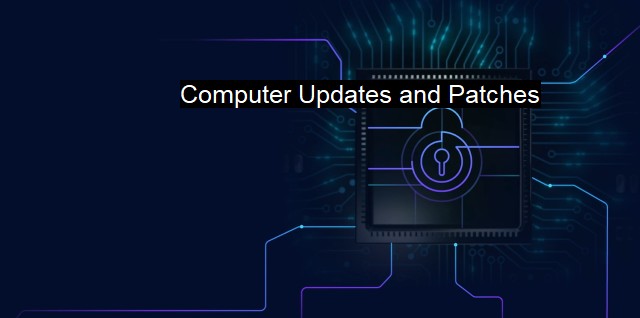What are Computer Updates and Patches?
The Vital Role of Computer Updates and Patches in Cybersecurity: Understanding How They Work and Their Importance in Protecting Against Malware Attacks
Computer updates and patches are two essential components in maintaining a secure and fast-paced computing environment. In the context of cybersecurity and antivirus mechanisms, understanding the scope of these features is pivotal. They enhance the performance of the system, secure data, and ward off potential threats from various malware and malicious entities.A computer update, by definition, is a comprehensive process where modified and improved versions of applications, drivers, firmware, or software are installed on the computer system. These updates, rolled-out by software vendors or operating system’s engineers, usually encompass enhancements in the system's functions, bug fixes, enhancement of system compatibility, and improvement in the overall stability of the software or application. Apart from these, an essential aspect of a computer update involves the strengthening of security. When applied, updates enhance a system's resistance against potential cyber threats including viruses, trojans, ransomware, and other malicious software.
Imagine that computer updates serve as a renewed defense system for your computational settings. For instance, when Microsoft releases an update for its Windows operating system, it doesn’t just aim to deliver better user experience but also focuses on rectifying bugs, closing off security loopholes which could be exploited otherwise, and enhancing the computer’s immunity against potential cyber threats. Hence, such updates are crucial in defining the health of your system under the landscape of cybersecurity.
Meanwhile, a patch is a piece of software designed to update, fix, or improve a computer program or its supporting data. It entails correcting errors that had not been discovered before the software's release or ensuring that the software continues to run when new bugs appear. In some cases, patches specifically cater to fixing discovered vulnerabilities exploited by notably perilous malware like ransomware or spyware. Therefore, patches are also considered minor updates that are aimed at fixing specific problems with a software.
The function of a patch, as mentioned, is to mend the software, and the repairs usually come in the form of code. Similarly patches play a crucial role. IT professionals and security analysts often hunt for software vulnerabilities. Whenever they identify a bug or an error that may potentially be exploited by cybercriminals, a patch is immediately formulated to replace or modify the faulty code. Once a patch is applied to the system, the vulnerability is consequently eliminated, rendering useless any malicious code that tried to exploit the previously existing vulnerability.
Proper management of computer updates and patches within organizations can greatly enhance the level of cybersecurity. By identifying the suitable updates or patches and implementing them at the right times, potential security vulnerabilities can be adequately treated. The consequences of not staying updated can expose the system to various forms of cyber threats including, but not limited to, data loss, unauthorized access of sensitive information, and system crashes.
Timely computer updates and patches signify a healthy computer system. This practice is not just a proactive measure against potential cyber threats, but it’s also a fundamental aspect of ongoing system maintenance. Software security is intrinsically tied to updates and patches that protect and enhance computer systems over time.
Computer updates and patches offer an important layer of protection against continuous cyber threats. Through these preventative actions, individual users and organizations alike safeguard their valuable data and ensure system longevity. Any neglect towards regular updates and patches can result in vulnerabilities that can be callously exploited by cybercriminals. Hence, as the advent of digitization sweeps the globe, the need to prioritize such cyber security efforts is not just recommended, but also critically important.

Computer Updates and Patches FAQs
What are computer updates and patches?
Computer updates and patches are software updates that are released by software manufacturers to fix bugs, improve system performance, and address security vulnerabilities. They include new features, bug fixes, and security enhancements.Why are computer updates and patches important for cybersecurity?
Computer updates and patches are important for cybersecurity because they fix security vulnerabilities that can be exploited by cybercriminals to gain unauthorized access to your computer system. Regularly updating your computer software can prevent cyber attacks, data breaches, and other security incidents.How often should I update my computer software?
It is recommended to update your computer software as soon as updates and patches are available. Software manufacturers release updates and patches regularly to address security vulnerabilities and fix bugs. So, it is essential to keep your software up-to-date to ensure maximum protection against cyber attacks.What is the best way to update my computer software?
The best way to update your computer software is to enable automatic updates for your software applications, including your antivirus software. This ensures that your software is always up-to-date and protected from the latest cyber threats. Alternatively, you can manually check for updates and patch your software from the manufacturer's website.| | A | | | B | | | C | | | D | | | E | | | F | | | G | | | H | | | I | | | J | | | K | | | L | | | M | |
| | N | | | O | | | P | | | Q | | | R | | | S | | | T | | | U | | | V | | | W | | | X | | | Y | | | Z | |
| | 1 | | | 2 | | | 3 | | | 4 | | | 7 | | | 8 | | |||||||